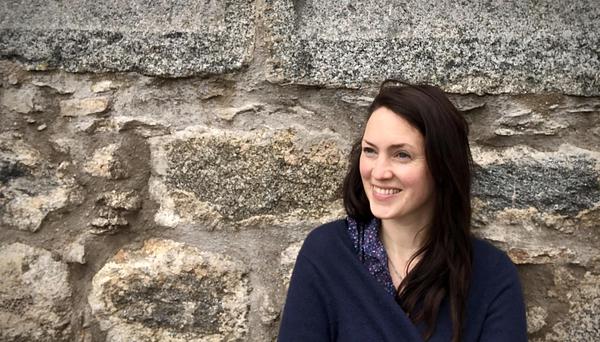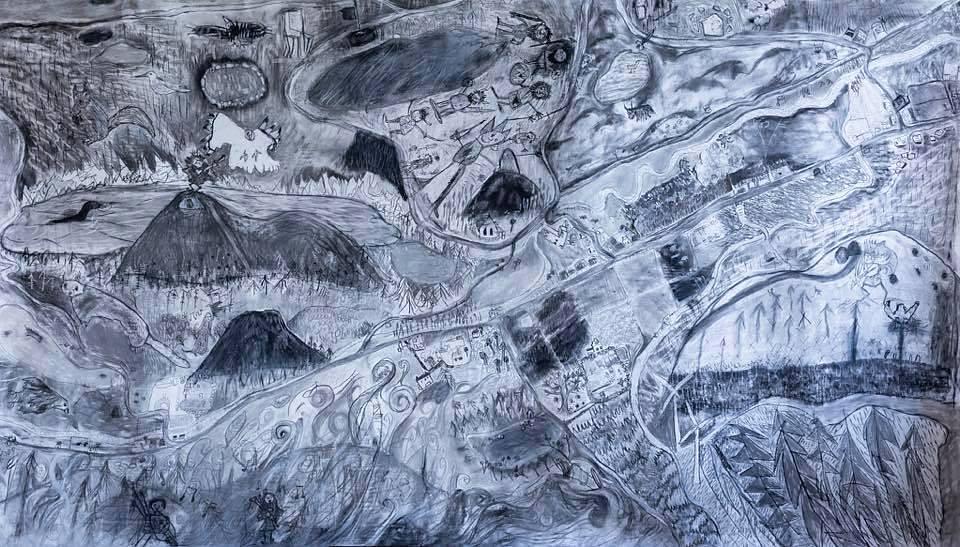
In praise of B roads
This month’s Tobar an Dualchais contribution comes from Raghnaid Sandilands, a writer, Gaelic translator, cartographer and publisher originally from Balmacara, Lochalsh, but now based in Strathnairn on the South side of Loch Ness

In this strange hibernation, with quiet roads and journeys n foot, what one friend has called the ‘intimacies of the home-patch’* have become their own study.
I’ve been taking the B roads from my door by bike or on foot and exploring online archives related to my home for some time and I’d like to write here in praise of both.
Katherine Stewart, author of A Croft in the Hills, was someone who grasped the ‘whole savour of living’. She lived on the other side of Loch Ness, at Abriachan, and was an animateur of great things in the community there. She said when writing about connections to place;
‘If a human is to hold onto his identity, he must somehow or other keep on making his own discoveries.’
Tobar an Dualchais, along with other digital archives, has helped me make my own discoveries; new places, new songs, new stories and also people. Finding treasures in song lines and stories, online archaeological records, old maps or satellite images is remarkably easy; an instant cyber archaeology.
I grew up in Lochalsh and moved back North 10 years ago, to Strathnairn, South of Inverness, to the right latitude at least. I began writing small essays for the local newsletter, on place-names or local sites, as a way to get to know the lie of the land, and have since kept a blog about these diversions. Finding stories of people and places and illustrating essays with photos, new maps or recordings, has been a means to make this place feel like home, more vividly our own.
In 2014, I helped initiate Farr Conversations here, a talk series set up to ‘oil the wheels of engagement with issues affecting Scotland’. As part of an evening we held on land reform with Lesley Riddoch, we thought to produce a small alternative map - a souvenir for the night. Here was a chance to bring to light some of the detail and character particular to the place. In privileging songs, stories, droving routes, names that were too long to fit on council road signs, making this map felt like an affirming, quietly radical thing to do. The cover design was a take on the blue and black Bartholomew maps, Gaelic on one side, English the other. The song words were set out on the reverse of the map. All folded by hand in the wee hours. The village hall was packed and I recall the rustling of those two hundred maps being opened.
Julie Fowlis and Eamon Doorley opened the night with a special set, music from the straths of South Loch Ness. One was a hunting song by Aonghas Cameron of Stratherrick, ‘Seinn Iùro bhinn O Ho’ and a version sung by Dr Allan MacDonald (20625) helped inspire their performance. It was beautiful to hear the song, warm and soaring and about love of place, brought back into the air space - oxygen for the heart.
’S toil leam àirigh nam badan
far am b’èibhinn leam cadal,
’s am biodh fasgadh ri gailleann
aig aighean ’s aig laoigh.
Agus frìth nan damh donna
’s nan ceannardan troma,
leam bu mhiann dol nan coinneamh
nuair a chromadh a’ ghrian…
I like the wooded high pasture
where I am glad to sleep,
where there’d be shelter from storms
for heifers and calves.
And the deer forest of the red stags,
of the heavy antlered heads,
how I loved to meet them
when the sun descended...
Later I went by bike to find Aonghas Cameron’s steading at Loch a’ Bhodaich with its red tin roof intact and rowans by the door.
At the end of that night a friend said to me, and I think this is the heart of it, “If you know the stories, you love the place, and if you love the place you look after it.” You have an idea of ownership, of care.
Tobar an Dualchais has a recording of a Strathnairn man, Finlay Smith, and his wife Jessie speaking to Professor Nicolaisen about the place names of the area (81647). In it, he mentions as a boy, an old ploughman living at the nearest ruins to us across the moor. With help from a neighbour, a keen genealogist, we found the name of the ploughman. He was Uilleam Mac a’ Chlèirich (Clarke) born in 1790 and he married a girl from a mile further up the river, Anna Nic an Tòisich (MacIntosh). They lived on and worked the land at Baile Dubh for forty years. Another conversation, this time with local historian Willie Forbes, and I was shown a letter home from New Zealand. It was from Anna’s sister who had left aged 18, along with most of her family, in 1885. She wrote as an old woman, a lifetime later, words that suggest that economic successes still leave a longing in the heart. Her descendants came to their family’s ruins some years ago and took stones back with them.
Today, when my children play out at the ruins, it feels like a kindness to know the names of these neighbours through time and to be able to tell a little of their story.
One of the best things about this pastime, this cultural mending and darning, is the process of search and discovery itself – through conversations, perhaps leading to the name of someone else who could know more; a visit, books to borrow, or a photo in a family album, directions drawn by hand. There are always new connections to be found.
Another wonderful thing, and it is joyous, is seeing the immediate appeal that stories of their own place have for children.
As well as personal stories of people and places, the landscape is rich in myth and legend. What child doesn’t need to know about their very own giant and Pan Celtic superhero, Fionn MacCumhail, fighting Vikings up the road?
A little scribed mention of ‘Cathair Fhionn’ on the first edition OS maps of the area, excised from the next edition, was the first clue. The Canmore online archaeological catalogue mentioned several sites nearby connected to this lore; as well as the ‘cathair’, the stone seat for the victorious Fionn, there was a fold where the Fianna readied for battle, Clach na Brataich, the banner stone and tumullti of the fallen.
We themed the local Fèis Farr that year on Fionn’s adventures, and Tobar an Dualchais was a rich resource. The stories we found were the catalyst for role play and games, shadow puppet re-tellling, songs, banner making and a visit to the sites. Coming upon the old stone fold of Buaile a’ Chòmhraig for the first time was a memorable thing; a large circle of white lichen covered stones, disappeared in plantation wood and largely forgotten for a generation. Indiana Jones eat your heart out!
A while after this, my son, looking up to where the wind-farm sits, asked, “is a giant bigger than a wind turbine?” I was unsure. If so, he thought, they’d make great ‘fidget spinners’ for Fionn. Wee imaginations fire well on these stories!

Last summer, the Fèis made a giant charcoal map of the area, illustrated with characters from these stories. We spent three afternoons outside, hearing stories in Gaelic and English and drawing them into the landscape, along with their familiar places and wildlife; ospreys, red divers and squirrels. Sitting by the sìthean, the fairy hill at the back of the wood, one girl was busy knocking her charcoal stick on the paper. ‘It’s the sound of the fairy blacksmith’s hammer’ she said. I love the instinctive, playful way the children make these stories their own.
Making our own discoveries actively connects us to our past, our present, our future. It inspires us to think imaginatively and creatively about what our worlds once were, and what they could be.
When it comes to the archives, I think of these finds as brèaghach - patterned shards, fragments, gifts from another time, offered up on the swell of a fortuitous search. They are an invite to play, to extend the pattern, imagine the rest, to somehow mend the shape. There is a wealth of material to be found and put to use; all it takes to make a start is a digital shift of the sands.
Perhaps, just as on that evening in the village hall, these are kindly, small radical acts, putting long-forgotten names of people, places and their stories back on the map. And if, for a while, we can put heroes in the hills and kelpies in the loch, then that is all to the good. We are all the better for some wonderment.
* This phrase was used by Cait O’Neill McCullagh in March 2020, in her own writing about home close walking during the pandemic.